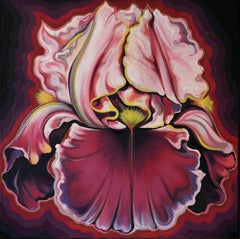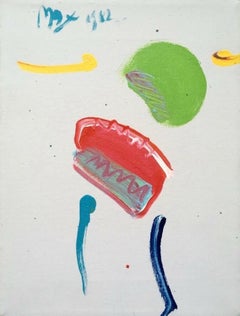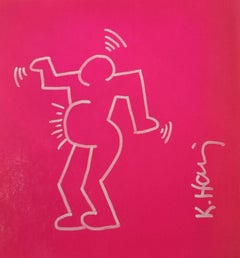Aaron Fink (American, b. 1955)
Hand signed and dated 1986, verso.
The large canvas size measures approx: 72" x 66". This painting is part of the artist's "Images of Gambling" series, amongst his best figural work.
Aaron Fink was born in Boston in 1955. He received his MFA from Yale University and his BFA from the Maryland Institute College of Art. His work has been exhibited widely throughout the U.S., Europe and Japan and Australia, and is included in the collections of the Museum of Modern Art, NY, the Art Institute of Chicago, the Museum of Fine Arts, Boston and the Walker Art Center, Minneapolis, among many others. He lives and works in the Boston area. He has been the subject of solo exhibitions at the Massachusetts Institute of Technology, the Muskegon Museum of Art, Michigan, the Rockford Art Museum, Illinois, and Colorado State University, Fort Collins. Figurative abstract expressionist art.
In 2002 a monograph on Fink’s work, Out of the Ordinary, was published, with text by Eleanor Heartney. In 1983 Fink met the collector John Powers, who remained a strong supporter of his work until his death in 1999. Fink’s work is represented in the collections of the Art Institute of Chicago, the Hara Museum, Tokyo, the Metropolitan Museum of Art, New York, the Museum of Modern Art, New York and the National Gallery of Art, Washington, DC, among many others. Fink currently divides his time between Boston and Rockport, Massachusetts.
He was included in the show The Expressive Voice: Selections from the Permanent Collection at the Danforth Museum of Art. An exhibition of Boston Expressionism, a school that embraced a distinctive blend of visionary painting, dark humor, religious mysticism, and social commentary. Historical roots of this movement can be traced to European Symbolism and German Expressionism, but artists living and working in the Boston area from the 1930’s through the 1950’s, were particularly inspired by Chaim Soutine and Max Beckmann. Artists included; Aaron Fink,
Bernard Chaet, David Aronson, Ernst Ludwig Kirchner, Hyman Bloom, Jack Levine, Jackson Pollock, Jason Berger, Karl Zerbe, Lawrence Kupferman, Michael Mazur, Sigmund Abeles and Willem de Kooning.
He was included in the show 40 Years of Printmaking: From the Center Street Studio Archives, along other great figural artists Gabor Peterdi, John Walker, Lester Johnson and Nell Blaine.
S E L E C T E D C O L L E C T I O N S
Art Institute of Chicago
Bank of America
Boston Public Library
Bouwfonds Nederlandse Gemeenten, The Netherlands
Brooklyn Museum of Art
Castelli Collection, New York
Chase Manhattan Bank
Chemical Bank
Choate Rosemary Hall, Wallingford, CT
Citizens Bank, Boston
Coopers & Lybrand
Danforth Museum, Framingham, MA
Danish House of Parliament
Davis Museum, Wellesley College, Wellesley, MA
DeCordova Museum and Sculpture Park Lincoln, MA
Farnsworth Museum, Maine
Fidelity Investments, Boston
Fogg Museum of Art, Harvard University, Cambridge, MA
Fuller Museum of Art, Brockton, MA
G.E. Corporation
Goldman Sachs & Company
IBM, New York
Indianapolis Museum of Art
Library of Congress
Massachusetts Institute of Technology, Cambridge, MA
Metropolitan Museum of Art, New York
Museum of Contemporary Art, Chicago
Museum of Fine Arts, Boston
Museum of Modern Art, New York
National Gallery of Art, Washington, DC
New York Public Library
Philadelphia Museum of Art
Portland Museum of Art, Portland, Maine
United States Department of State
University of Massachusetts, Amherst
Awards
Residency, Anderson Ranch, Snowmass, CO, 1998, 1996
National Endowment for the Arts, 1987, 1982
Artist Fellowship, Massachusetts Council on the Arts and Humanities, 1984
American Academy in Rome, Prix de Rome – Alternate in Painting, 1979
Yale University, Ford Foundation Special Project Grant, Fall 1979
Skowhegan Scholarship Award, conferred by the Maryland Institute College of Art, Spring 1976
SELECTED GROUP EXHIBITIONS
Contemporary Responses to Modernism: A New England Perspective, University of Southern Maine
Color and Line: Expressive Tradition in Boston, Endicott College, Beverly, MA,
Beautiful Decay, Danforth Art Museum, Framingham, MA
MICA Then and Now, Ethan Cohen Gallery, Beacon, NY
Bon Appetit, Concord Art Association
Celebrating Ten Years, Galerie D’Avignon, Montreal, Canada
New England Impressions: Exploring the Woodcut, Concord Art, Concord, MA
Go Figure: The Figure in Contemporary Art – A Response to Art History,
Painting in Boston: 1950-2000, DeCordova Museum and Sculpture Park, Lincoln, MA
Working Sources: The Painter and the Photographic Image, Alpha Gallery, Boston, MA
The Unique Print: Six Innovative Approaches to the Monotype, Starr Gallery, Newton, MA
Selections from Atelier Mourlot, Hankyu Department Store, Tokyo, Japan
Yale Collects Yale, Yale University Art Gallery, New Haven, CT, 1993
70’s and 80’s: Printmaking Now, Museum of Fine Arts, Boston, MA, 1986-1987
Skowhegan Alumni, Leo Castelli Gallery, New York, and Portland Museum of Art, Portland, Maine,
Public and Private: American Prints Today, Brooklyn Museum, Brooklyn, NY
Contemporary Miami Collectors, Metropolitan Museum, Coral Gables, FL, 1984
The American Artist as Printmaker, Brooklyn Museum, Brooklyn, NY, 1983-84
Jon Abbott, Aaron Fink, Tom Lieber,
Chris Wool...



